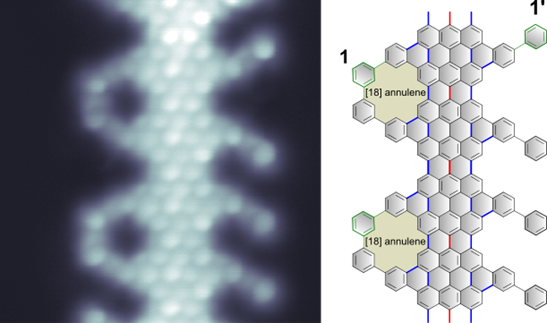Thursday, 03 October 2024
ICN2 Researchers Develop Innovative Method for Creating Nanometric Pores in Graphene
This recent study represents a significant advance in the synthesis of complex graphene-based nanostructures and could have major implications for a wide range of technologies.

Scientists from the ICN2 Atomic Manipulation and Spectroscopy Group, led by ICREA Prof. Aitor Mugarza, have developed a new efficient strategy for the synthesis of novel graphene-based porous nanomaterials with atomic precision. This collaborative study, which includes researchers from other institutions such as Donostia International Physics Centre, the University of the Basque Country (UPV/EHU), and the University of Santiago de Compostela (USC), has been published in the journal Nature Communications Chemistry.
A milestone in the on-surface synthesis of nanostructures
Specifically, the researchers succeeded in selectively inducing the formation of a specific type of pore, known as 18-annulene pores (as shown in the image above), at the edges of graphene nanoribbons (GNRs). These GNRs consist of atomically thin, planar carbon nanostructures that could be obtained if one had a “nanoscissor” that could cut graphene strips into any shape with atomic precision. However, this nanofabrication tool does not yet exist, so we have to rely on LEGO-like synthetic chemistry, in which molecular building blocks designed by solution chemistry are self-assembled and transformed using catalytic surfaces and special thermal processes.
The paper describes a breakthrough in the on-surface synthesis of graphene nanostructures, a field that has made significant progress in recent years. This research field focuses on the production of atomically precise structures from diverse molecular precursors that act as building blocks that self-assemble on metallic surfaces. Until recently, the reactions used for this type of synthesis have been limited to a few specific strategies that involve the cleavage of some specific atoms or groups.
In this study, the researchers go further by adding a different type of reaction that involves not only the activation of sites by cleavage, but also the internal migration of specific functional groups. Functional groups can be defined as the specific groups of atoms within a molecule that are responsible for the characteristic chemical reactions of that molecule.
In particular, they used the migration of phenyl groups (a cyclic functional group composed of 5 hydrogen atoms and 6 carbon atoms) attached to the nanoribbons to create these types of pores at the edges of the structure. The feasibility of this reaction pathway has been confirmed by first-principles calculations. Overall, the sequential introduction of this new type of reaction paves the way for the creation of graphene nanostructures with a higher degree of structural complexity. This approach allows very precise control of the internal transformations taking place in these materials.
Conclusions and next steps
In summary, this work represents a significant advance in the on-surface synthesis of graphene-derived nanomaterials. The researchers have successfully developed a new chemical reaction sequence that allows the creation of porous GNRs with atomic precision. These findings could be useful or have a big impact on several technologies, such us the fabrication of advanced electronic devices and the development of new filtration and chemical sensing systems.
Reference article:
Moreno, C; Diaz de Cerio, X; Tenorio, M; Gao, F; Vilas-Varela, M; Sarasola A; Peña, D; Garcia-Lekue, A; Mugarza, A. On-surface synthesis of porous graphene nanoribbons mediated by phenyl migration. (2024). Nature Communications Chemistry. https://doi.org/10.1038/s42004-024-01284-2.

